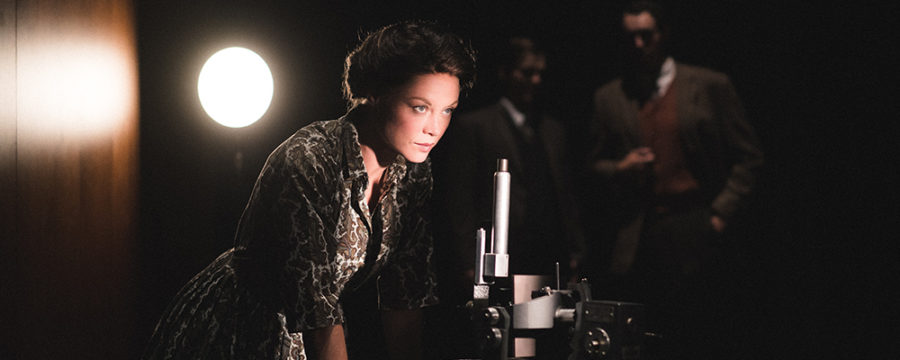Often, when one cracked open a textbook in middle school, the discovery of the structure of DNA was accredited to two scientists: James Watson—a University of Chicago graduate—and Francis Crick. Rosalind Franklin, meanwhile, usually got only a brief nod. It was a student of Franklin's, Ray Gosling, who captured the groundbreaking Photograph 51, which depicted DNA as a double helix structure and boosted the study of molecular biology and later engineering. Although schools have evolved to address Franklin’s studies more and more, her legacy is still forgotten by many. While the field of science was dominated by men in the mid-20th century, Franklin managed to retain her strength and motivation—a commendable feat which *Photograph 51* at Court Theatre portrays magnificently.
Chaon Cross performs as Franklin, a determined chemist pursuing a dream at King’s College to lead her own laboratory for the study of proteins. After a “misunderstanding,” she is forced to work as an “assistant,” or later, through a reluctant agreement, as “lab partner” of the renowned Maurice Wilkins, in an attempt to find the structure of DNA. Stuck in a situation she cannot alter, Franklin nonetheless continues to work in the lab, where she solves problems that her lab partner does not even notice, such as removing the humidity of the camera.
Franklin is portrayed as a no-nonsense “workaholic,” spending late nights in the lab analyzing and calculating her work, refusing to theorize and rather relying on her evidence to draw conclusions. In the lab, she is mechanical, hardworking, and emotionally cold, jabbing at Dr. Wilkins with sharp-tongued wit and responses to his alleged insults. However, she is obviously still a bright and unfortunately misunderstood character. Confident in her independence, she recognizes that what she lacks is a willingness to cooperate, showing a more vulnerable, self-aware side. She represses her emotions in order to spark her scientific motivation and accomplish her work in the lab, but admits that she desires to be kissed, to hike in the Swiss Alps and breathe in the fresh air, to wake up every morning happy to be alive. Even in the lab, she draws blanks about the true structure of DNA while gushing over a remarkable play she watched, revealing a side of Rosalind Franklin usually left unaddressed in history and our bio textbooks.
*Photograph 51* introduces Wilkins as the chemist who ruined Franklin. He almost never addresses Franklin as a fellow doctor, calling her “Rosie” behind her back and “Miss Franklin” to her face. He is constantly distracted by his own pride and attempts to bolster his own reputation in the scientific world, claiming Franklin’s work to be his own and showing off Photo 51 to Watson, who would later use it to discover the double helix structure. Wilkins protests against the narration throughout the play, arguing, “This isn’t how it happened,” denying him the ability to hide his own shame and the depressing reality that he could have salvaged Franklin’s dignity and befriended her before she passed away from cancer.
Watson and Crick are depicted as selfish, self-glorifying, and prideful thieves who care not for Franklin’s frustrations with them and are focused only on the Nobel Prize and their names being recognized for all of history. Watson is a cocky, boastful young doctor with barely any accomplishments, seizing his chances to steal Franklin’s work to establish his own title as “Discoverer of DNA Structure” in the textbooks—a character the audience would love to hate. However, Crick is a more sympathetic character. He is quieter and hints at regret as his private life crumbles, his wife leaving him gradually without his noticing as he becomes obsessed with his lab work. Nevertheless, the two dehumanize and sexualize Franklin during her official presentations, calling her crude names like “hag,” and teasing her body shape and choice of clothes. Their constant mocking of the female scientist reveals the revolting double standard in the scientific community, turning a blind eye to Franklin’s accomplishments and concentrating only on her physical attributes.
The characters of Don Caspar and Ray Gosling act as comic relief, while also further bringing out Franklin’s humanity. Caspar flatters Franklin, as an admirer of her work, and thanks her for her contributions in chemistry, something that seems to pleasantly surprise Franklin and make her feel validated in a world that has otherwise turned its back on her. Gosling, a lab assistant, is sometimes amusingly incompetent and gets in Franklin’s way, yet serves as a lens and narrator peering into Franklin’s life as she is demonized day-to-day.
Throughout Photograph 51, the men in the scientific community find ways to dominate over Franklin, prowling over her as she works, or interrupting or misinterpreting every remark she utters. Even the narration in the play is by the men, such that Rosalind does not voice her own story. But Franklin fights back, independent, tragically isolated, but always strong and pushing herself as an equal in the scientific field. The end of the play leaves a lonely Wilkins regretting not warming up to Franklin enough, making the audience wonder, What if someone, what if Wilkins, had simply recognized Franklin’s potential and honored her name as a legendary chemist?
Photograph 51 emphasizes the tragedy of not only the stolen ideas from Franklin’s data but also her lack of recognition as an equal or even as a competent human by her colleagues. The Court’s production is a powerful story of the real woman behind one of the greatest accomplishments in biological history.









